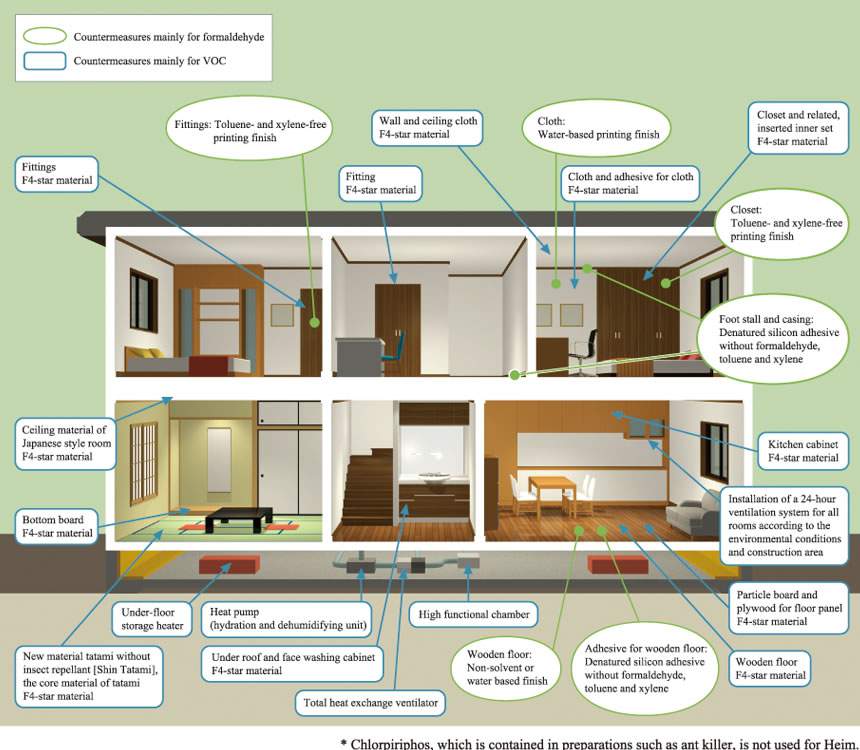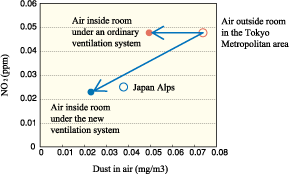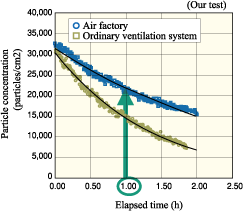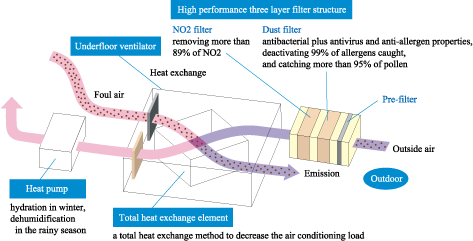Indoor air quality
We promptly addressed the formaldehyde issue at an early stage and achieved an indoor environment superior to the directive standards issued by the Ministry of Health, Welfare and Labor when the building of Heim was complete, ahead of other companies. In order to protect the health of your family, Heim maintains a clean indoor air environment.

Measures against formaldehyde - Using the highest quality members for the interior finishing material
The formaldehyde concentration in a room is determined by the proportion between the amount of formaldehyde emitted from the building material and the air ventilation. Based on the ventilation capacity of a building, the amended Building Standard Law defined the area of building material to be used for the building according to the amount of formaldehyde emitted from the same. However, the interior material used to construct Heim is not restricted by the Law governing the area to be used for a building and has the least amount of formaldehyde shown as a symbol of F 4-star material. This specification represents the highest grade under the Quality Assurance Law.
- *Quality Assurance Law: Law on Promotion to Ensure the Quality of Houses


- *Desiccator method: a plate in which 300 ml distilled water, and the designated test body are placed in a sealed container, the temperature is maintained at a designated level and the amount of formaldehyde dissolved into the distilled water is measured after 24 hours.
- *0.3 for plywood and panels, 0.2 for wall paper and less than 0.12 for paint (unit mg/l)
Measures against VOCs - Our own standards governing the selection of members
Targeting the further enhancement of indoor air quality, we strive to take measures against volatile organic compounds (VOCs), which are currently not governed by national regulations. These are paint thinner substances, represented by toluene and xylene contained in adhesives. We have developed our own technology to measure VOCs and have determined the amounts of VOCs emitted from building materials, adhesives and decorated boards using this measurement technology. For Heim, we use materials that emit minimal amounts of VOCs.
Site management - reassuring measures derived only from the factory production system
All materials used in the Heim building site, including small items such as curing tapes and adhesives, are chosen in the factory based on our own standards. No materials are procured on-site to avoid the potential use of materials containing and/or emitting harmful chemicals. In addition, we continue intermittent 24-hour ventilation operation during the building period until delivery.
Prior to habitation, the concentrations of chemicals (formaldehyde, toluene and xylene) are measured
Prior to delivery, a "Residence quality measurement expert", namely a qualified professional from Sekisui, measures the concentrations of formaldehyde, toluene and xylene in the building to confirm that these levels clear the provisions of the Heim guidelines.
- *The results of the measurement are provided to the customer.
What are toluene and xylene?
Toluene and xylene are commonly known chemicals of volatile organic compounds (VOCs), which are contained in many commercially available solvents and thinners. These chemicals are harmful to human health when inhaled for long periods. Toluene is cheap and most frequently used as a solvent for paints, printing ink and adhesives. It smells like gasoline. Xylene is also used for solvents and most solvents also contain toluene. The chemical has almost the same smell and usage as toluene.
One of the main causes of sick building syndrome
What is formaldehyde?
The chemical has high volatility, becoming gaseous matter at room temperature, and irritates mucous membranes with its strong smell. When included in a 37% water solution, it is commonly known as formalin. It is thought to be a cause of allergosis and regulations specify that it must not be detected in textile goods used for babies aged two and under.
Measures to maintain indoor air quality - an indoor air quality equivalent to that of the Japan Alps, "air factory" is our new ventilation system
A ventilator installed under the floor takes in outdoor air, purifies it with an industrial quality filter to remove dust, pollen and NO2, and sends the purified air to several inlets installed on each floor via a duct. The inhaled air circulates within rooms like a boomerang and returns to the exhaust outlet containing dust, ticks and mold, from where it is discharged outdoors. This ventilation system maintains good indoor air quality with 24-hour ventilation all year round. As the fluctuation of power caused by differences in temperature and barometric pressure between outdoors and indoors is minimized, the system is far more efficient than one independently operating inhale and exhale ventilators.
The under floor ventilator used is of the heat exchange type to reduce heat loss.
As the air, which is inhaled through the high performance filter, also runs through a dehumidifier, this controls the growth of ticks and mold.


after futon bed making (2µm example)

